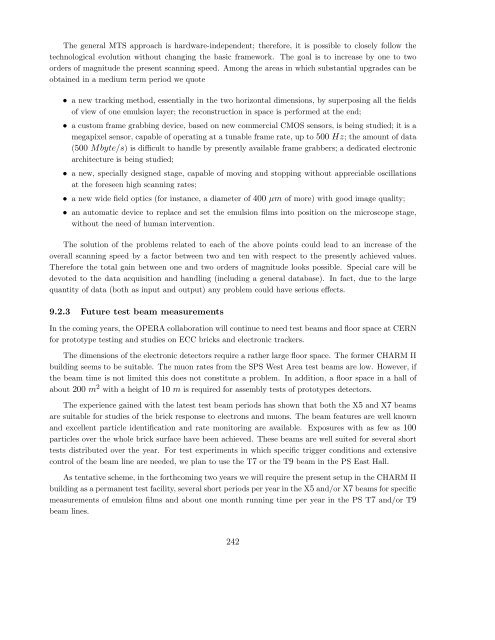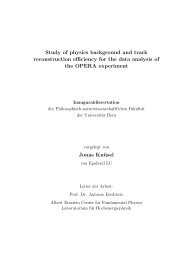Experiment Proposal - opera - Infn
Experiment Proposal - opera - Infn
Experiment Proposal - opera - Infn
You also want an ePaper? Increase the reach of your titles
YUMPU automatically turns print PDFs into web optimized ePapers that Google loves.
The general MTS approach is hardware-independent; therefore, it is possible to closely follow the<br />
technological evolution without changing the basic framework. The goal is to increase by one to two<br />
orders of magnitude the present scanning speed. Among the areas in which substantial upgrades can be<br />
obtained in a medium term period we quote<br />
• a new tracking method, essentially in the two horizontal dimensions, by superposing all the fields<br />
of view of one emulsion layer; the reconstruction in space is performed at the end;<br />
• a custom frame grabbing device, based on new commercial CMOS sensors, is being studied; it is a<br />
megapixel sensor, capable of <strong>opera</strong>ting at a tunable frame rate, up to 500 Hz; the amount of data<br />
(500 Mbyte/s) is difficult to handle by presently available frame grabbers; a dedicated electronic<br />
architecture is being studied;<br />
• a new, specially designed stage, capable of moving and stopping without appreciable oscillations<br />
at the foreseen high scanning rates;<br />
• a new wide field optics (for instance, a diameter of 400 µm of more) with good image quality;<br />
• an automatic device to replace and set the emulsion films into position on the microscope stage,<br />
without the need of human intervention.<br />
The solution of the problems related to each of the above points could lead to an increase of the<br />
overall scanning speed by a factor between two and ten with respect to the presently achieved values.<br />
Therefore the total gain between one and two orders of magnitude looks possible. Special care will be<br />
devoted to the data acquisition and handling (including a general database). In fact, due to the large<br />
quantity of data (both as input and output) any problem could have serious effects.<br />
9.2.3 Future test beam measurements<br />
In the coming years, the OPERA collaboration will continue to need test beams and floor space at CERN<br />
for prototype testing and studies on ECC bricks and electronic trackers.<br />
The dimensions of the electronic detectors require a rather large floor space. The former CHARM II<br />
building seems to be suitable. The muon rates from the SPS West Area test beams are low. However, if<br />
the beam time is not limited this does not constitute a problem. In addition, a floor space in a hall of<br />
about 200 m 2 with a height of 10 m is required for assembly tests of prototypes detectors.<br />
The experience gained with the latest test beam periods has shown that both the X5 and X7 beams<br />
are suitable for studies of the brick response to electrons and muons. The beam features are well known<br />
and excellent particle identification and rate monitoring are available. Exposures with as few as 100<br />
particles over the whole brick surface have been achieved. These beams are well suited for several short<br />
tests distributed over the year. For test experiments in which specific trigger conditions and extensive<br />
control of the beam line are needed, we plan to use the T7 or the T9 beam in the PS East Hall.<br />
As tentative scheme, in the forthcoming two years we will require the present setup in the CHARM II<br />
building as a permanent test facility, several short periods per year in the X5 and/or X7 beams for specific<br />
measurements of emulsion films and about one month running time per year in the PS T7 and/or T9<br />
beam lines.<br />
242




